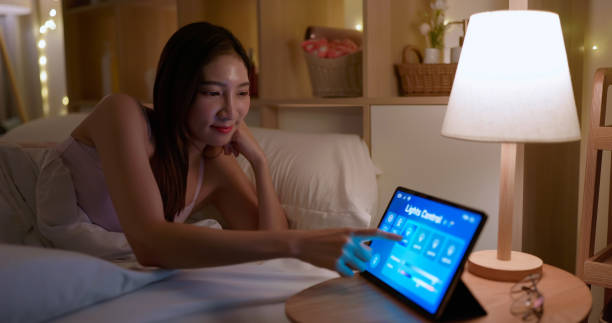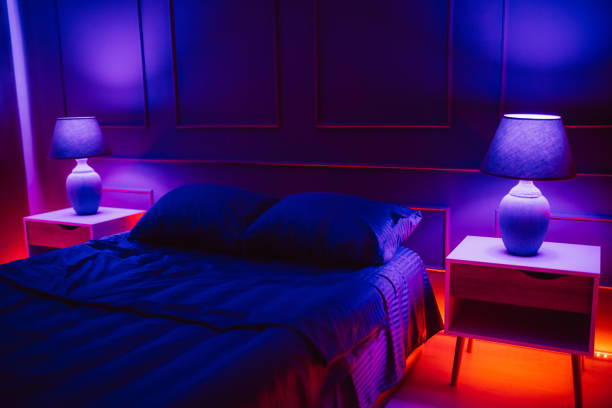
In today’s smart home landscape, using smart lights for your sleep-wake cycle has become one of the most effective ways to enhance your sleep quality and overall well-being. Whether you’re looking to create a gentle wake-up lighting system or automate your bedroom lighting to support your natural rhythms, the right smart home lighting for sleep can make all the difference. From popular brands like Philips Hue and Google Nest to customizable circadian rhythm lighting automation, setting up your smart lights correctly helps you fall asleep faster and wake up refreshed. In this guide, we’ll walk you through how to set up smart lights for sleep, including tips on sunrise alarm light setup and creating personalized routines that fit your lifestyle.
What Is a Sleep-Wake Cycle and Why Does It Matter?

Your sleep-wake cycle, also known as the circadian rhythm, is an internal 24-hour clock that governs when you feel alert and when you feel sleepy. It’s heavily influenced by exposure to light and darkness. Natural sunlight helps regulate this rhythm by signaling your brain when to produce melatonin, the hormone that induces sleep.
However, artificial lighting—especially blue light from screens and harsh indoor lights—can disrupt this rhythm, making it harder to fall asleep or wake up naturally. Aligning your indoor lighting to mimic natural daylight patterns ca support melatonin production, improve sleep quality, and enhance daytime alertness.
How Smart Lights Can Help Regulate Your Sleep-Wake Cycle

Smart lighting systems are designed to simulate natural light changes throughout the day. They can gradually dim in the evening with warm tones to prepare your body for rest and brighten with cool, blue-enriched light in the morning to boost alertness. This human-centric lighting approach is gaining traction as a wellness trend in 2025.
Popular smart lighting brands like Philips Hue, Google Nest, and GE C-Sleep offer features such as:
- Gradual dimming and brightening: Mimics sunset and sunrise
- Tunable color temperatures: Warmer light in the evening, cooler light in the morning
- Automation and scheduling: Lights adjust automatically based on your routine
- Voice control integration: Control lights hands-free with Alexa, Google Assistant, or Siri
For example, users report better sleep onset and less grogginess upon waking when using sunrise simulation modes in their smart lights.
Step-by-Step Guide to Setting Up Smart Lights for Your Sleep-Wake Cycle

Step 1: Choose the Right Smart Lighting System
Look for bulbs or fixtures that offer tunable white light (adjustable color temperature) and support automation. Philips Hue and Google Nest are excellent choices with proven circadian lighting features.
Step 2: Install and Connect Your Smart Lights
Set up your smart bulbs and connect them to your home Wi-Fi network via the manufacturer’s app. Integrate with your smart home hub or voice assistant for easier control.
Step 3: Create Automation Schedules
Program your lights to:
- Dim gradually 30-60 minutes before bedtime with warm tones (around 2200K to 2700K) to signal your body to wind down.
- Brighten gradually 15-30 minutes before your wake-up time with cool, bright light (4000K to 6500K) to simulate sunrise and boost alertness.
Most apps allow you to customize these schedules based on your preferred sleep and wake times.
Step 4: Customize Color Temperatures
Use warmer colors in the evening to reduce blue light exposure and cooler colors in the morning to increase alertness. Avoid bright, blue-enriched light at night, as it can suppress melatonin.
Step 5: Use Voice Commands and Scenes
Set up voice commands like “Good Night” or “Wake Up” to activate your lighting scenes instantly. Create scenes such as “Relax,” “Sleep,” and “Morning” for easy access.
Placement Tips
Position your smart lights where they can influence your environment effectively—bedroom ceiling lights, bedside lamps, or smart light strips behind furniture work well. Avoid placing lights behind heavy curtains or blocked by furniture.
Popular Automation Examples and Scenes to Try

- Evening Wind-Down: Lights dim to a soft amber glow over 45 minutes before bedtime.
- Sunrise Simulation: Lights brighten from 0% to 100% over 20 minutes at your wake-up time.
- Reading Mode: Warm, dim light with moderate brightness for relaxing before sleep.
- Daytime Focus: Bright, cool light to boost productivity and mood during the day.
You can also sync your smart lights with alarms or other smart devices for a seamless morning routine.
Benefits Backed by Science and User Experiences

Research shows that exposure to gradually increasing light in the morning helps reduce sleep inertia—the groggy feeling after waking—and improves cognitive function3. Circadian lighting supports melatonin regulation, leading to deeper, more restorative sleep.
Users often report waking up more refreshed and experiencing fewer mid-night awakenings when using smart lights with circadian features. One case study showed that a family using Philips Hue lights with sunrise simulation experienced improved sleep quality and better mood throughout the day.
Tips on Sunrise Alarm Light Setup
Setting up your sunrise alarm light correctly is key to enjoying a natural, gentle wake-up experience that aligns with your sleep-wake cycle. Whether you’re using a dedicated sunrise alarm clock or smart bulbs with wake-up features, these tips will help you optimize your setup for the best results:
- Choose the Right Wake-Up Duration: Most sunrise alarms allow you to set the light to gradually brighten over 10 to 60 minutes. A 20 to 30-minute fade-in period is ideal for a smooth transition from sleep to wakefulness without feeling jolted.
- Set the Wake-Up Time First: Decide the exact time you want to wake up and program your alarm accordingly. The sunrise simulation will start before this time based on your chosen fade duration.
- Adjust Brightness and Color Temperature: Start with a dim, warm light (deep red or amber tones) that gradually becomes brighter and cooler (daylight white) to mimic natural sunrise and stimulate alertness.
- Position Lights Strategically: Place your smart bulbs or alarm light where the light can reach your eyes easily, such as bedside lamps or ceiling fixtures facing your bed, to maximize the effect.
- Use App or Voice Controls for Flexibility: Many smart lighting systems let you customize your wake-up routine via apps or voice assistants like Google Nest or Alexa, making it easy to tweak settings or activate the light remotely.
- Repeat Schedule Consistently: Set your sunrise alarm to repeat on weekdays or daily to help reinforce your circadian rhythm and establish a regular sleep-wake pattern.
- Combine with Gentle Sounds (Optional): Some sunrise alarms include nature sounds or soft music that can complement the light and further ease your wake-up process.
By following these tips, you can create a personalized sunrise alarm light setup that enhances your mornings and supports a healthier sleep routine.
Frequently Asked Questions (FAQs)
Q1: What color light is best for sleep and wake-up?
Warm light (2200K–2700K) is best in the evening to promote melatonin production, while cool light (4000K–6500K) is ideal in the morning to increase alertness.
Q2: Can smart lights help with insomnia?
Yes, by regulating your circadian rhythm and reducing exposure to disruptive blue light at night, smart lights can improve sleep onset and quality.
Q3: How long before bedtime should I start dimming the lights?
Start dimming lights 30 to 60 minutes before your intended sleep time for optimal effect.
Q4: Are smart lights safe to use all night?
Using very dim, warm night lights is generally safe and can prevent disruption. Avoid bright or blue-toned lights overnight.
Q5: Can I control smart lights remotely?
Yes, most smart lighting systems allow remote control via smartphone apps, so you can adjust settings even when away from home.
Conclusion
Setting up smart lights to support your sleep-wake cycle is a simple yet powerful way to improve your sleep quality and overall well-being. By mimicking natural light patterns through gradual dimming and color temperature shifts, smart lighting helps regulate your circadian rhythm, making mornings easier and nights more restful. With growing innovations in AI, voice control, and health-centric lighting, 2025 is the perfect time to embrace smart lighting for a healthier lifestyle.
Explore the latest smart lighting options and start your journey toward better sleep and brighter mornings today at smarthomesbee.com.